Muhammad Imran Malik
Block Induced Signature Generative Adversarial Network (BISGAN): Signature Spoofing Using GANs and Their Evaluation
Oct 08, 2024



Abstract:Deep learning is actively being used in biometrics to develop efficient identification and verification systems. Handwritten signatures are a common subset of biometric data for authentication purposes. Generative adversarial networks (GANs) learn from original and forged signatures to generate forged signatures. While most GAN techniques create a strong signature verifier, which is the discriminator, there is a need to focus more on the quality of forgeries generated by the generator model. This work focuses on creating a generator that produces forged samples that achieve a benchmark in spoofing signature verification systems. We use CycleGANs infused with Inception model-like blocks with attention heads as the generator and a variation of the SigCNN model as the base Discriminator. We train our model with a new technique that results in 80% to 100% success in signature spoofing. Additionally, we create a custom evaluation technique to act as a goodness measure of the generated forgeries. Our work advocates generator-focused GAN architectures for spoofing data quality that aid in a better understanding of biometric data generation and evaluation.
A Perspective Analysis of Handwritten Signature Technology
May 22, 2024



Abstract:Handwritten signatures are biometric traits at the center of debate in the scientific community. Over the last 40 years, the interest in signature studies has grown steadily, having as its main reference the application of automatic signature verification, as previously published reviews in 1989, 2000, and 2008 bear witness. Ever since, and over the last 10 years, the application of handwritten signature technology has strongly evolved, and much research has focused on the possibility of applying systems based on handwritten signature analysis and processing to a multitude of new fields. After several years of haphazard growth of this research area, it is time to assess its current developments for their applicability in order to draw a structured way forward. This perspective reports a systematic review of the last 10 years of the literature on handwritten signatures with respect to the new scenario, focusing on the most promising domains of research and trying to elicit possible future research directions in this subject.
Few-Shot Learning for Biometric Verification
Nov 12, 2022



Abstract:In machine learning applications, it is common practice to feed as much information as possible. In most cases, the model can handle large data sets that allow to predict more accurately. In the presence of data scarcity, a Few-Shot learning (FSL) approach aims to build more accurate algorithms with limited training data. We propose a novel end-to-end lightweight architecture that verifies biometric data by producing competitive results as compared to state-of-the-art accuracies through Few-Shot learning methods. The dense layers add to the complexity of state-of-the-art deep learning models which inhibits them to be used in low-power applications. In presented approach, a shallow network is coupled with a conventional machine learning technique that exploits hand-crafted features to verify biometric images from multi-modal sources such as signatures, periocular region, iris, face, fingerprints etc. We introduce a self-estimated threshold that strictly monitors False Acceptance Rate (FAR) while generalizing its results hence eliminating user-defined thresholds from ROC curves that are likely to be biased on local data distribution. This hybrid model benefits from few-shot learning to make up for scarcity of data in biometric use-cases. We have conducted extensive experimentation with commonly used biometric datasets. The obtained results provided an effective solution for biometric verification systems.
KENN: Enhancing Deep Neural Networks by Leveraging Knowledge for Time Series Forecasting
Feb 16, 2022

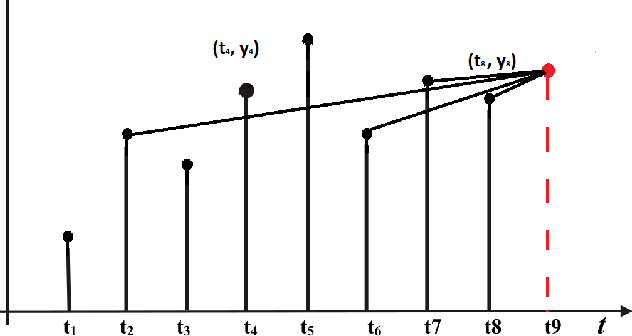
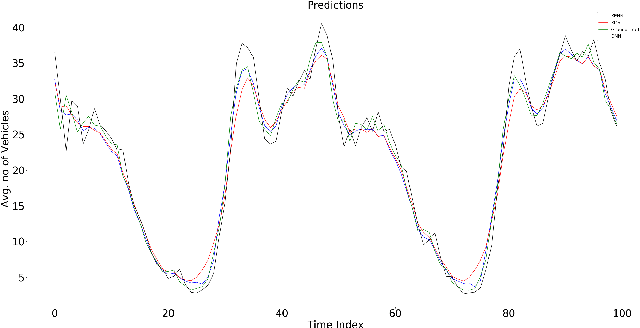
Abstract:End-to-end data-driven machine learning methods often have exuberant requirements in terms of quality and quantity of training data which are often impractical to fulfill in real-world applications. This is specifically true in time series domain where problems like disaster prediction, anomaly detection, and demand prediction often do not have a large amount of historical data. Moreover, relying purely on past examples for training can be sub-optimal since in doing so we ignore one very important domain i.e knowledge, which has its own distinct advantages. In this paper, we propose a novel knowledge fusion architecture, Knowledge Enhanced Neural Network (KENN), for time series forecasting that specifically aims towards combining strengths of both knowledge and data domains while mitigating their individual weaknesses. We show that KENN not only reduces data dependency of the overall framework but also improves performance by producing predictions that are better than the ones produced by purely knowledge and data driven domains. We also compare KENN with state-of-the-art forecasting methods and show that predictions produced by KENN are significantly better even when trained on only 50\% of the data.
ExAID: A Multimodal Explanation Framework for Computer-Aided Diagnosis of Skin Lesions
Jan 04, 2022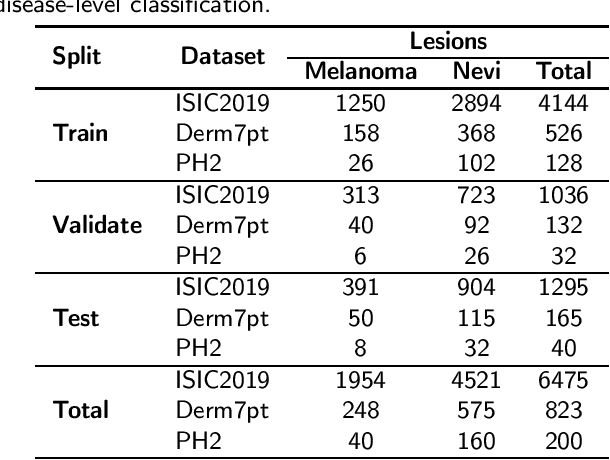
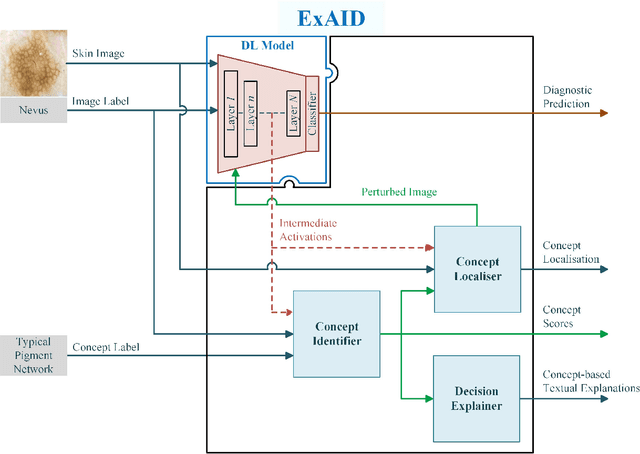
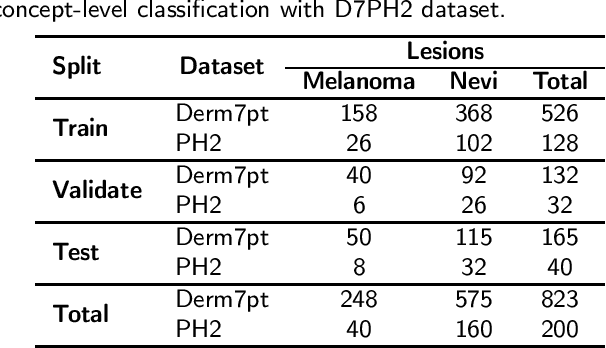
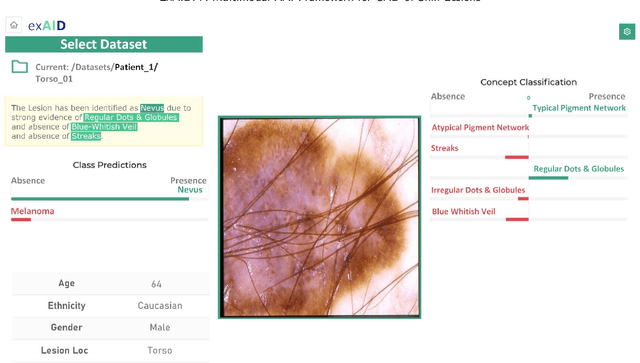
Abstract:One principal impediment in the successful deployment of AI-based Computer-Aided Diagnosis (CAD) systems in clinical workflows is their lack of transparent decision making. Although commonly used eXplainable AI methods provide some insight into opaque algorithms, such explanations are usually convoluted and not readily comprehensible except by highly trained experts. The explanation of decisions regarding the malignancy of skin lesions from dermoscopic images demands particular clarity, as the underlying medical problem definition is itself ambiguous. This work presents ExAID (Explainable AI for Dermatology), a novel framework for biomedical image analysis, providing multi-modal concept-based explanations consisting of easy-to-understand textual explanations supplemented by visual maps justifying the predictions. ExAID relies on Concept Activation Vectors to map human concepts to those learnt by arbitrary Deep Learning models in latent space, and Concept Localization Maps to highlight concepts in the input space. This identification of relevant concepts is then used to construct fine-grained textual explanations supplemented by concept-wise location information to provide comprehensive and coherent multi-modal explanations. All information is comprehensively presented in a diagnostic interface for use in clinical routines. An educational mode provides dataset-level explanation statistics and tools for data and model exploration to aid medical research and education. Through rigorous quantitative and qualitative evaluation of ExAID, we show the utility of multi-modal explanations for CAD-assisted scenarios even in case of wrong predictions. We believe that ExAID will provide dermatologists an effective screening tool that they both understand and trust. Moreover, it will be the basis for similar applications in other biomedical imaging fields.
Combining Fine- and Coarse-Grained Classifiers for Diabetic Retinopathy Detection
May 28, 2020



Abstract:Visual artefacts of early diabetic retinopathy in retinal fundus images are usually small in size, inconspicuous, and scattered all over retina. Detecting diabetic retinopathy requires physicians to look at the whole image and fixate on some specific regions to locate potential biomarkers of the disease. Therefore, getting inspiration from ophthalmologist, we propose to combine coarse-grained classifiers that detect discriminating features from the whole images, with a recent breed of fine-grained classifiers that discover and pay particular attention to pathologically significant regions. To evaluate the performance of this proposed ensemble, we used publicly available EyePACS and Messidor datasets. Extensive experimentation for binary, ternary and quaternary classification shows that this ensemble largely outperforms individual image classifiers as well as most of the published works in most training setups for diabetic retinopathy detection. Furthermore, the performance of fine-grained classifiers is found notably superior than coarse-grained image classifiers encouraging the development of task-oriented fine-grained classifiers modelled after specialist ophthalmologists.
Two-stage framework for optic disc localization and glaucoma classification in retinal fundus images using deep learning
May 28, 2020



Abstract:With the advancement of powerful image processing and machine learning techniques, CAD has become ever more prevalent in all fields of medicine including ophthalmology. Since optic disc is the most important part of retinal fundus image for glaucoma detection, this paper proposes a two-stage framework that first detects and localizes optic disc and then classifies it into healthy or glaucomatous. The first stage is based on RCNN and is responsible for localizing and extracting optic disc from a retinal fundus image while the second stage uses Deep CNN to classify the extracted disc into healthy or glaucomatous. In addition to the proposed solution, we also developed a rule-based semi-automatic ground truth generation method that provides necessary annotations for training RCNN based model for automated disc localization. The proposed method is evaluated on seven publicly available datasets for disc localization and on ORIGA dataset, which is the largest publicly available dataset for glaucoma classification. The results of automatic localization mark new state-of-the-art on six datasets with accuracy reaching 100% on four of them. For glaucoma classification we achieved AUC equal to 0.874 which is 2.7% relative improvement over the state-of-the-art results previously obtained for classification on ORIGA. Once trained on carefully annotated data, Deep Learning based methods for optic disc detection and localization are not only robust, accurate and fully automated but also eliminates the need for dataset-dependent heuristic algorithms. Our empirical evaluation of glaucoma classification on ORIGA reveals that reporting only AUC, for datasets with class imbalance and without pre-defined train and test splits, does not portray true picture of the classifier's performance and calls for additional performance metrics to substantiate the results.
* 16 Pages, 10 Figures
G1020: A Benchmark Retinal Fundus Image Dataset for Computer-Aided Glaucoma Detection
May 28, 2020



Abstract:Scarcity of large publicly available retinal fundus image datasets for automated glaucoma detection has been the bottleneck for successful application of artificial intelligence towards practical Computer-Aided Diagnosis (CAD). A few small datasets that are available for research community usually suffer from impractical image capturing conditions and stringent inclusion criteria. These shortcomings in already limited choice of existing datasets make it challenging to mature a CAD system so that it can perform in real-world environment. In this paper we present a large publicly available retinal fundus image dataset for glaucoma classification called G1020. The dataset is curated by conforming to standard practices in routine ophthalmology and it is expected to serve as standard benchmark dataset for glaucoma detection. This database consists of 1020 high resolution colour fundus images and provides ground truth annotations for glaucoma diagnosis, optic disc and optic cup segmentation, vertical cup-to-disc ratio, size of neuroretinal rim in inferior, superior, nasal and temporal quadrants, and bounding box location for optic disc. We also report baseline results by conducting extensive experiments for automated glaucoma diagnosis and segmentation of optic disc and optic cup.
On Interpretability of Deep Learning based Skin Lesion Classifiers using Concept Activation Vectors
May 05, 2020
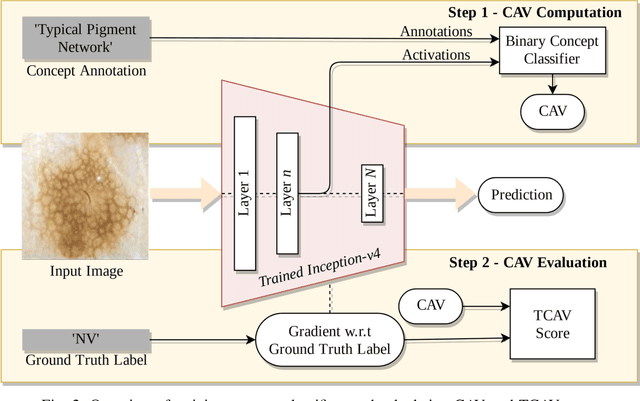

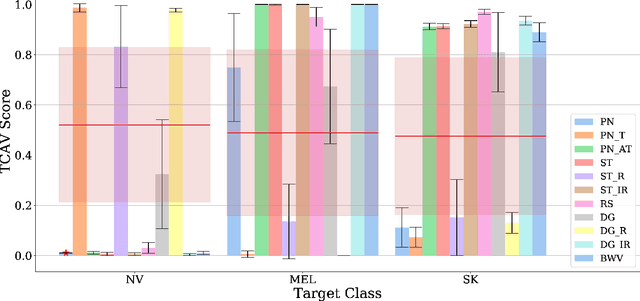
Abstract:Deep learning based medical image classifiers have shown remarkable prowess in various application areas like ophthalmology, dermatology, pathology, and radiology. However, the acceptance of these Computer-Aided Diagnosis (CAD) systems in real clinical setups is severely limited primarily because their decision-making process remains largely obscure. This work aims at elucidating a deep learning based medical image classifier by verifying that the model learns and utilizes similar disease-related concepts as described and employed by dermatologists. We used a well-trained and high performing neural network developed by REasoning for COmplex Data (RECOD) Lab for classification of three skin tumours, i.e. Melanocytic Naevi, Melanoma and Seborrheic Keratosis and performed a detailed analysis on its latent space. Two well established and publicly available skin disease datasets, PH2 and derm7pt, are used for experimentation. Human understandable concepts are mapped to RECOD image classification model with the help of Concept Activation Vectors (CAVs), introducing a novel training and significance testing paradigm for CAVs. Our results on an independent evaluation set clearly shows that the classifier learns and encodes human understandable concepts in its latent representation. Additionally, TCAV scores (Testing with CAVs) suggest that the neural network indeed makes use of disease-related concepts in the correct way when making predictions. We anticipate that this work can not only increase confidence of medical practitioners on CAD but also serve as a stepping stone for further development of CAV-based neural network interpretation methods.
A Robust and Precise ConvNet for small non-coding RNA classification
Dec 23, 2019



Abstract:Functional or non-coding RNAs are attracting more attention as they are now potentially considered valuable resources in the development of new drugs intended to cure several human diseases. The identification of drugs targeting the regulatory circuits of functional RNAs depends on knowing its family, a task which is known as RNA sequence classification. State-of-the-art small noncoding RNA classification methodologies take secondary structural features as input. However, in such classification, feature extraction approaches only take global characteristics into account and completely oversight co-relative effect of local structures. Furthermore secondary structure based approaches incorporate high dimensional feature space which proves computationally expensive. This paper proposes a novel Robust and Precise ConvNet (RPC-snRC) methodology which classifies small non-coding RNAs sequences into their relevant families by utilizing the primary sequence of RNAs. RPC-snRC methodology learns hierarchical representation of features by utilizing positioning and occurrences information of nucleotides. To avoid exploding and vanishing gradient problems, we use an approach similar to DenseNet in which gradient can flow straight from subsequent layers to previous layers. In order to assess the effectiveness of deeper architectures for small non-coding RNA classification, we also adapted two ResNet architectures having different number of layers. Experimental results on a benchmark small non-coding RNA dataset show that our proposed methodology does not only outperform existing small non-coding RNA classification approaches with a significant performance margin of 10% but it also outshines adapted ResNet architectures.
 Add to Chrome
Add to Chrome Add to Firefox
Add to Firefox Add to Edge
Add to Edge